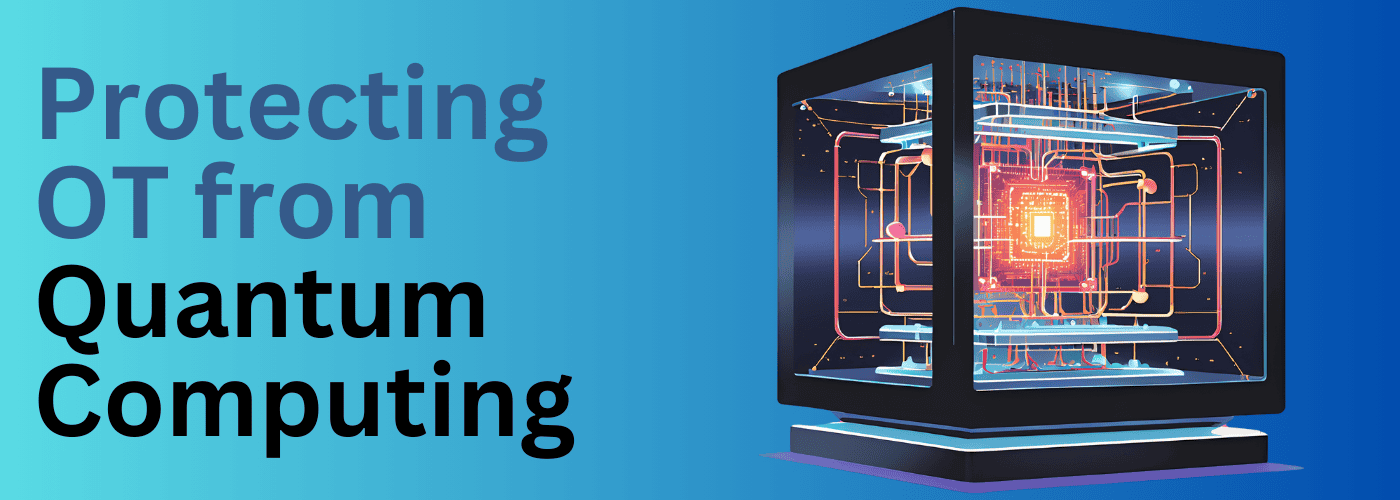Protecting Operational Technology from Quantum Computing

Protecting OT from Quantum Computing
What is Quantum Computing?
Quantum computing leverages the principles of quantum mechanics to perform complex calculations far more efficiently than classical computers. Unlike classical bits, which represent data as 0 or 1, quantum bits (qubits) can exist in multiple states simultaneously due to superposition. This, along with entanglement—where qubits become interconnected and the state of one can instantly affect another—enables quantum computers to process vast amounts of data in parallel. These properties make quantum computing ideal for solving problems in cryptography, optimization, and simulation that are currently not possible for traditional computers.
Post-quantum cryptography (PQC) refers to cryptographic algorithms designed to be secure against the potential threats posed by quantum computers. While quantum computers have the capability to break today’s widely-used cryptographic algorithms, post-quantum cryptographic algorithms aim to resist (quantum resistance) such attacks. These algorithms are based on mathematical problems believed to be hard even for quantum computers. The transition to post-quantum cryptography is essential for ensuring device and data security in a future where quantum computing becomes mainstream, safeguarding sensitive information against future decryption threats.
Key Reasons for PQC Protection
Implementing PQC for operational technology (OT) systems is crucial due to the increasing potential for quantum computers to break current encryption algorithms and the long lifecycles of OT devices.
-
Quantum Threat Mitigation
- Quantum computers have the theoretical capability to break classical encryption schemes like RSA and ECC by leveraging algorithms such as Shor’s algorithm. This puts critical systems, including OT networks, at risk.
- By adopting PQC, OT systems are better equipped to withstand future attacks from quantum computers, ensuring that sensitive data and communications remain secure in the post-quantum era.
-
Protection of Long-Lived Assets
- OT systems in industries such as energy, manufacturing, utilities and building automation often have long lifecycles, sometimes spanning decades. Encrypting device authentication and data today with classical methods might leave them vulnerable to quantum attacks in the future.
- Implementing PQC now ensures that long-term protection is in place, mitigating risks even if quantum breakthroughs occur several years from now.
-
Critical Infrastructure Security
- OT systems are often part of critical infrastructure (power grids, transportation, water treatment plants), making them high-value targets for cyberattacks.
- A successful quantum attack on these systems could lead to severe real-world consequences, including disruption of essential services. PQC can protect these systems from advanced cyber threats.
-
Compliance with Future Regulations
- Governments and regulatory bodies are beginning to recognize the quantum threat. It’s likely that future regulations will require the implementation of quantum-resistant cryptographic methods.
- Proactively adopting PQC helps OT operators stay ahead of regulatory requirements and ensures compliance with future standards.
-
Secure Communications
- OT systems rely on secure device-level communications for automation and control. If quantum computers break the cryptography protecting these channels, attackers could intercept or manipulate these communications, leading to potential sabotage.
- PQC can help maintain the integrity and confidentiality of communications within OT environments.
-
Data Integrity and Authenticity
- Quantum attacks could not only decrypt data but also forge digital signatures and certificates. For OT systems that rely on authentication mechanisms to ensure the integrity of commands and data, post-quantum algorithms will be essential to prevent forgery.
- This ensures that commands being executed in critical systems are legitimate, protecting against unauthorized manipulation.
-
Future-Proofing
- Even though large-scale quantum computers are not yet fully developed, the transition to PQC takes time. By implementing PQC now, OT systems can be future-proofed against emerging quantum threats.
- Early adoption ensures that OT environments won’t be caught off guard once quantum computing becomes a reality.
Adopting post-quantum cryptography for operational technology systems is a forward-looking strategy that ensures the continued security and integrity of critical infrastructure in the face of rapidly advancing quantum technologies.
To explore how Veridify products can contribute to material improvements in your own OT security posture, please reach out to us for a free consultation.
Keywords: Protecting OT from Quantum Computing



